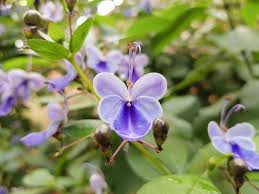Clerodendrum Genus: A Fascinating Exploration
The genus Clerodendrum is a captivating group of flowering plants, known for its vibrant beauty and intriguing characteristics. Commonly referred to as glorybower, bagflower, and bleeding-heart, these plants belong to the Lamiaceae family, which includes around 236 genera and over 7,000 species.
Unique Traits of Clerodendrum
Clerodendrum bungei and Clerodendrum trichotomum are standout species within this genus, each offering unique features that make them beloved in gardens. C. bungei is admired for its large, fragrant pink flower heads that bloom from late summer through autumn. Interestingly, while the flowers are sweetly scented, the leaves release a peculiar smell reminiscent of burning rubber when rubbed.
On the other hand, C. trichotomum is known for its peanut butter-scented leaves and small, fragrant white flowers. After the flowers fade, the plant produces striking iridescent blue berries surrounded by bright pink calyces, adding an unexpected splash of color to the garden.
Growth and Maintenance
Both C. bungei and C. trichotomum are deciduous plants, which means they shed their leaves annually. This characteristic allows gardeners to maximize space by planting winter and spring bulbs around these plants, creating a dynamic and ever-changing garden display.
Clerodendrum bungei requires regular pruning, especially in mid-winter, where cutting the flowering stems down to the ground every 2 to 3 years helps maintain its vigor. Conversely, C. trichotomum needs occasional shaping to keep its form neat.
Challenges and Considerations
One challenge with growing Clerodendrum species is their tendency to sucker, which can lead to the spread of the plants beyond their intended area. While this can be a problem in some gardens, in shaded or root-infested areas, such as under large trees, the suckering habit can be beneficial, helping to fill empty spaces.
Clerodendrum quadriloculare, another species in this genus, is known for its invasive tendencies, especially in tropical regions like Hawaii and Micronesia. This species spreads rapidly through seeds and root suckers, often dominating areas and forming dense monocultures under forest canopies.
Conclusion
The genus Clerodendrum offers a fascinating array of plants that can enhance any garden with their unique scents, vibrant flowers, and intriguing growth habits. While some species may pose challenges, such as invasiveness or suckering, careful management can turn these traits into assets, adding diversity and interest to garden landscapes. Whether you’re drawn to the burning rubber scent of C. bungei or the peanut butter fragrance of C. trichotomum, Clerodendrum plants are sure to bring a touch of the exotic to your garden.




